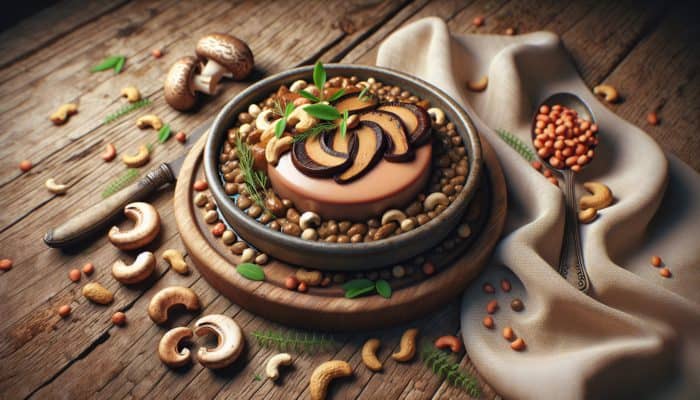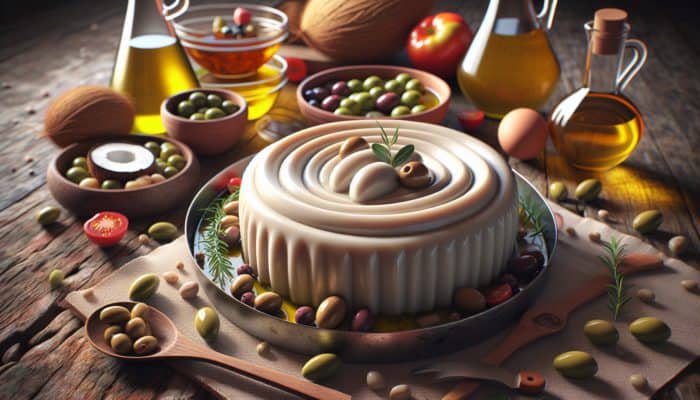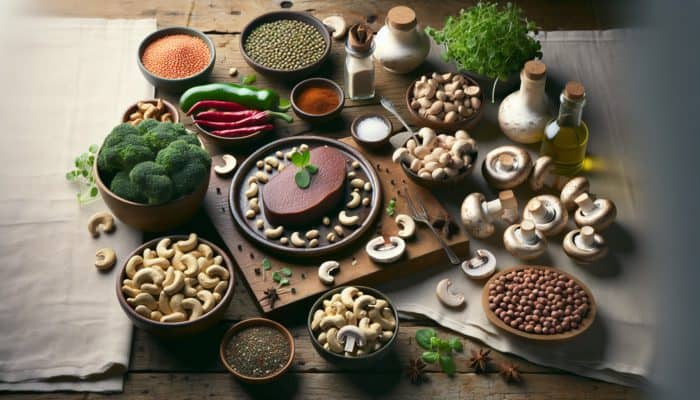Essential Ingredients for Crafting Vegan Foie Gras
Key Base Ingredients for Vegan Foie Gras

When embarking on the journey to create a delectable vegan foie gras alternative, it is essential to focus on the right selection of mushrooms, nuts, and legumes. These foundational ingredients not only provide a satisfying texture but also deliver a rich depth of flavour that is crucial for achieving a taste profile similar to traditional foie gras.
Particular mushroom varieties, such as shiitake or portobello, are excellent choices due to their umami-rich qualities, which form the backbone of your dish. Their meaty texture perfectly mimics the mouthfeel of animal-based foie gras. Meanwhile, nuts like cashews or walnuts are packed with healthy fats and can create a creamy consistency when blended. Additionally, legumes such as lentils or chickpeas contribute both protein and substantial texture to your mixture.
Ultimately, the selection of these components should reflect what is available in your local market and cater to your personal taste preferences. This flexibility allows you to craft a vegan foie gras that not only aligns with your culinary style but also promotes ethical and sustainable eating habits.
Enhancing Flavours for Vegan Foie Gras
To elevate your vegan foie gras to new heights, the incorporation of flavour enhancers is vital. Ingredients like miso paste, soy sauce, and nutritional yeast are fantastic for adding complexity and depth to your dish.
Miso paste brings a savoury, fermented profile that can significantly enhance the overall taste of your creation. Meanwhile, soy sauce adds an element of saltiness and richness, and nutritional yeast contributes a cheesy, nutty flavour that pairs beautifully with the other ingredients. These flavour enhancers can be blended in various combinations to discover the ideal balance, allowing for a personalised touch in each batch of your vegan foie gras.
Don't hesitate to experiment with different ratios of these ingredients until you discover a combination that satisfies your palate. The objective is to achieve a robust, well-rounded taste that closely resembles the indulgence of traditional foie gras while remaining completely plant-based.
Critical Binding Agents for Texture
In order to achieve the desired consistency in your vegan foie gras, the inclusion of binding agents is absolutely essential. Options such as agar agar and tapioca flour serve to hold the mixture together, creating a cohesive texture that enhances the overall experience.
Agar agar, which is derived from seaweed, acts as a powerful gelling agent well-suited for vegan cooking. It sets quickly and provides a firm texture reminiscent of traditional foie gras. Alternatively, tapioca flour can be used to thicken and bind the mixture, lending it a creamy quality. The quantities of these agents may need to be adjusted based on the other ingredients and the final consistency you wish to achieve.
In practice, it's advisable to start with a small amount, then gradually increase as necessary, blending thoroughly to ensure an even distribution throughout your mixture. This careful approach will help you achieve the perfect texture that can stand up to traditional varieties while remaining entirely plant-based.
Choosing the Right Fat Substitutes

The luxurious richness associated with traditional foie gras is often attributed to the fats used in its preparation. To replicate this sensation in a vegan context, it is important to select appropriate fat substitutes like coconut oil or olive oil. Each option offers a unique flavour profile that can influence the overall taste and mouthfeel of your vegan foie gras.
Coconut oil is especially effective due to its creamy texture and ability to solidify when chilled, making it a fantastic choice for achieving a similar consistency to animal fats. In contrast, olive oil introduces a fruity note that can enhance the overall flavour, particularly when combined with other ingredients. The selection of the right fat substitute will depend on the flavour you want to highlight, whether it be the sweetness of coconut or the earthiness of olive oil.
As you experiment with these fats, consider how each interacts with other components of your dish. The ideal blend will create a rich and indulgent experience that stays true to the essence of traditional foie gras without compromising on plant-based principles.
Seasonings and Spices to Perfect Your Vegan Foie Gras
The finishing touch to your vegan foie gras lies in the meticulous selection of seasonings and spices. Incorporating fresh herbs like thyme or spices such as black pepper can significantly elevate the taste profile of your dish.
Thyme, known for its aromatic qualities, pairs beautifully with the earthiness of mushrooms and nuts, creating a harmonious blend of flavours. Meanwhile, black pepper adds a subtle heat that can enhance the overall taste experience. You might also consider adding a hint of garlic or shallots for additional depth. Adjust these seasonings according to your personal preferences, ensuring they complement rather than overshadow the core ingredients.
- Experiment with both fresh and dried herbs for varied flavour profiles.
- Incorporate aromatic spices to add layers of complexity.
- Balance the saltiness of other ingredients with herbal notes.
- Season gradually, tasting as you go to ensure the perfect blend.
Ultimately, the right combination of seasonings can transform your vegan foie gras from a mere substitute into a delightful dish that stands on its own.
Expert Tips for Crafting a Vegan Foie Gras Alternative
How to Select the Best Ingredients

Choosing the right ingredients for your vegan foie gras is crucial in replicating the complex flavours and textures found in its traditional counterpart. Key considerations include texture, flavour profile, and nutritional value. Each component plays a significant role in the final dish, so meticulous attention to detail is essential.
- Texture: Seek out ingredients that create a rich and creamy mouthfeel.
- Flavour Profile: Select components that contribute umami flavours and depth.
- Nutritional Value: Keep in mind the health benefits of the ingredients you use.
- Availability: Opt for ingredients that are easily sourced locally to promote sustainability.
For example, choosing cashews as a base can provide creaminess, while mushrooms deliver a savoury character that is difficult to surpass. Additionally, consider any dietary restrictions or preferences when selecting your ingredients, ensuring your vegan foie gras can be enjoyed by a wider audience.
What Techniques Enhance the Flavour of Vegan Foie Gras?
To maximise the flavour of your vegan foie gras, employing a variety of cooking techniques can be immensely beneficial. Methods like sautéing, roasting, or blending can dramatically enhance the overall taste, drawing out unique notes in your ingredients.
Sautéing mushrooms in olive oil can amplify their natural flavours while caramelising the edges, adding much-needed depth for any rich dish. Roasting nuts can also enhance their flavour, making them more aromatic and palatable. Finally, blending the mixture after cooking ensures that all flavours meld together seamlessly, resulting in a harmonious final product.
Experiment with these techniques to uncover which best suits your flavour preferences. Each method presents distinct advantages, allowing you to create a vegan foie gras that not only replicates the original but also offers a unique culinary experience.
How to Achieve the Ideal Texture in Vegan Foie Gras
Achieving the right texture in your vegan foie gras is crucial for delivering a satisfying eating experience. From the blending process to chilling, each step plays a vital role in determining the final consistency of your dish. Start by blending your base components until they reach a smooth consistency; you may need to add liquid or more solid ingredients to reach your desired texture.
Ensure that your mixture is thoroughly blended because any chunks can disrupt the creamy texture characteristic of traditional foie gras. The cooking method you select will also impact texture—pan-frying can yield a crispy outer layer, while baking might result in a softer consistency.
Once you've cooked your mixture, chilling it is essential for proper setting. Allow it to cool in the refrigerator for several hours or, ideally, overnight. This cooling period is crucial for ensuring that the mixture firms up without losing creaminess. The contrast between a firm exterior and a rich interior is what makes vegan foie gras truly exceptional.
What Are the Steps to Prepare Vegan Foie Gras?
How to Blend the Ingredients Effectively
The first step in preparing vegan foie gras involves blending your chosen ingredients. To achieve a smooth consistency, combine your base components with flavour enhancers and binding agents until the mixture is cohesive and well-integrated.
Begin by placing your prepared mushrooms, nuts, and legumes into a high-powered blender or food processor. Add your selected flavour enhancers, such as miso or soy sauce, to ensure a well-rounded taste. Including binding agents like agar agar or tapioca flour at this stage is crucial, as these will help to achieve the desired firmness in the final product.
Adjust the consistency as needed by adding small amounts of liquid, such as vegetable broth, or additional solid ingredients if the mixture appears too thin. Blend until completely smooth, scraping down the sides as necessary to ensure everything is evenly mixed. This initial blending step is critical for creating a luxurious and creamy texture that beautifully mimics traditional foie gras.
What Cooking Methods Can Be Used for Vegan Foie Gras?
The next phase in preparing vegan foie gras involves selecting a cooking method that aligns with your taste preferences. Options like pan-frying for a crispy exterior or baking for a softer texture can create unique sensory experiences.
For a richer flavour profile, consider pan-frying your blended mixture in a small amount of oil. This technique creates a delightful crust that enhances the overall texture and adds a layer of complexity to the dish. Alternatively, baking the mixture in a loaf pan can yield a more traditional pâté-like consistency, allowing the flavours to meld beautifully as they cook.
Experimenting with these methods will reveal which best suits your personal palate. Each technique offers distinct benefits, enabling you to create a vegan foie gras that is tailored to your unique tastes and stands out as a gourmet delight.
How to Chill and Set Vegan Foie Gras Properly
Once your vegan foie gras has been cooked, the next crucial step is chilling and setting the mixture. This process allows the flavours to develop further and the texture to firm up, achieving the desired consistency.
Transfer the cooked mixture into an appropriate container, whether a loaf pan or individual serving dishes. Cover tightly to prevent air from affecting the texture. Then, place it in the refrigerator for several hours or, preferably, overnight. This chilling period is vital for allowing the agar agar or other binding agents to work effectively, resulting in a firmer structure.
When it's time to serve, gently remove the vegan foie gras from the container. The cool temperature enhances its refreshing quality, making it an excellent addition to any platter. Taking care with the presentation is crucial, as the aesthetic appeal of your vegan foie gras can significantly elevate the dining experience.
What Ingredients Should Be Selected for Vegan Foie Gras?
As previously mentioned, selecting high-quality plant-based ingredients is vital for preparing vegan foie gras. Essential ingredients like cashews, mushrooms, and coconut oil serve as the foundation of your recipe, effectively mimicking the rich texture and flavour profile of traditional foie gras.
Whenever possible, opt for fresh, organic produce, as this will enhance the overall quality of your dish. For instance, the choice of nuts can greatly impact the creaminess of your final product. Soaking cashews prior to blending can achieve an ultra-smooth texture, which is particularly desirable in a pâté.
Additionally, consider the flavour characteristics of your selected ingredients. Mushrooms can provide a robust umami base, while high-quality oils can contribute depth and richness. This careful selection not only addresses ethical concerns but also significantly enhances the culinary experience.
Creative Garnishing and Serving Ideas
Presentation plays an essential role when serving vegan foie gras. Thoughtful garnishes can elevate both the visual appeal and taste of your dish, helping it to reach gourmet status. Consider using microgreens, edible flowers, or a drizzle of balsamic reduction to add a sophisticated touch.
Microgreens not only bring colour but also introduce a fresh flavour that contrasts beautifully with the richness of the foie gras. Edible flowers can add an artistic element to your presentation, turning your dish into a feast for the eyes. A balsamic reduction drizzled on top can introduce an acidic balance that cuts through the richness, creating a harmonious flavour profile.
Serve your vegan foie gras chilled or at room temperature, accompanied by crusty bread or crackers. This approach allows your guests to fully appreciate the nuanced flavours and textures you've meticulously crafted, making each bite a delightful experience.
What Are the Benefits of Choosing Vegan Foie Gras?
Ethical Considerations in Vegan Foie Gras Production
One of the most compelling motivations to enjoy vegan foie gras is the ability to avoid the ethical concerns associated with traditional foie gras production. The creation of traditional foie gras often involves practices that many consumers find distressing, such as force-feeding ducks or geese to enlarge their livers.
By opting for a plant-based alternative, you can relish the indulgence of foie gras without the ethical implications tied to its production. This humane choice resonates with a growing trend in the culinary world, as more individuals become conscious of animal rights and welfare.
Choosing vegan foie gras promotes a more compassionate culinary experience and encourages restaurants and food manufacturers to explore more humane methods of producing gourmet foods. Ultimately, this decision contributes to a broader shift in the food industry, advocating for ethical gastronomy.
Health Benefits of Vegan Foie Gras
From a health perspective, vegan foie gras offers numerous advantages over its traditional counterpart. Plant-based ingredients typically feature lower levels of cholesterol and saturated fats, making vegan foie gras a healthier option for those mindful of their dietary intake.
Incorporating nuts, legumes, and vegetables introduces beneficial nutrients such as fibre, vitamins, and minerals into your diet. These components support overall health and wellness, making vegan foie gras not just a treat but also a nutritious addition to your meals.
The plant-based composition allows consumers to enjoy the rich flavours without the associated health risks. This holistic approach to gourmet food makes vegan foie gras appealing to a broader audience, including those prioritising health alongside culinary excellence.
Environmental Impact of Vegan Foie Gras
Vegan foie gras significantly reduces environmental impact compared to traditional foie gras, primarily due to its plant-based ingredients. The production of animal products often requires significant resources, including land, water, and feed, leading to a substantial environmental footprint.
By choosing vegan alternatives, consumers can decrease resource use and greenhouse gas emissions associated with traditional animal farming. This shift promotes sustainability and aligns with a growing awareness of environmental issues within the food industry.
Furthermore, plant-based diets have been linked to lower rates of deforestation and habitat destruction, positively contributing to biodiversity preservation. Opting for vegan foie gras is not only a culinary choice but also an environmental one, supporting more sustainable food systems worldwide.
Culinary Versatility of Vegan Foie Gras
Vegan foie gras provides unparalleled culinary versatility, making it an exciting ingredient for both chefs and home cooks. Unlike traditional foie gras, which may have limited applications, vegan foie gras can be creatively used across an array of dishes.
Its rich, creamy texture makes it an ideal spread for bread or crackers, but it can also be seamlessly integrated into pasta sauces, salads, or as a component of a charcuterie board. This versatility encourages culinary innovation, allowing chefs to push boundaries and craft unique dining experiences.
Moreover, vegan foie gras can be adapted to suit various cuisines, making it a globally appealing dish. This adaptability fosters creativity and inspires culinary exploration, offering endless possibilities for delightful plant-based gourmet cooking.
Accessibility and Affordability of Vegan Foie Gras
A standout advantage of vegan foie gras lies in its accessibility and affordability when compared to traditional foie gras. Traditional foie gras is often regarded as a luxury item, associated with high production and sourcing costs.
Conversely, vegan foie gras can be crafted using readily available ingredients that are often more budget-friendly. This accessibility ensures that a wider audience can indulge in gourmet flavours without the hefty price tag, making it a more inclusive dining option.
This inclusivity can encourage more individuals to explore plant-based diets, promoting a shift towards sustainable eating habits. Additionally, the growing availability of vegan alternatives in restaurants and grocery stores further supports this accessibility, paving the way for more people to enjoy plant-based gourmet foods.
Research-Backed Insights into Creating Vegan Foie Gras
What Does Nutritional Analysis Reveal?
A comprehensive nutritional analysis of vegan foie gras indicates significant differences compared to traditional foie gras. While traditional foie gras is high in saturated fats and cholesterol, vegan alternatives typically boast lower levels of these components, making them a healthier choice.
Plant-based ingredients such as nuts and legumes provide healthy fats, protein, and fibre, contributing to a well-rounded nutritional profile. This shift not only benefits individual health but also promotes better heart health and reduces the risk of chronic diseases associated with high saturated fat intake.
Furthermore, vegan foie gras can be enriched with various vitamins and minerals, depending on the specific ingredients used. This nutritional advantage highlights the potential of plant-based alternatives in creating gourmet foods that align with health-conscious dietary choices.
Consumer Acceptance of Vegan Foie Gras
The evolution of consumer acceptance regarding vegan foie gras reflects changing attitudes towards plant-based diets. As awareness of animal welfare and environmental issues grows, more individuals are becoming open to trying vegan alternatives.
Real-world examples underscore this trend; restaurants are increasingly incorporating vegan foie gras into their menus, and brands are launching plant-based products that capture the essence of traditional delicacies. The rising demand indicates a shift in consumer preferences, with many seeking gourmet experiences without the ethical implications of animal products.
Market research reveals that consumers are willing to pay a premium for high-quality plant-based alternatives, signalling a positive trend for vegan foie gras and its acceptance in mainstream culinary culture.
What Do Sustainability Studies Suggest?
Research supports the idea that plant-based alternatives like vegan foie gras can contribute to more sustainable food systems. Studies indicate that plant-based diets require fewer resources and have a lower environmental impact than animal agriculture.
By investing in vegan alternatives, society can shift towards a more sustainable food future, reducing the carbon footprint linked to traditional farming practices. This transition supports environmental health and aligns with the growing consumer demand for sustainable options.
Additionally, embracing vegan alternatives can foster innovations in food production, creating a more resilient and sustainable food system. The movement towards plant-based foods is not merely a trend but a necessary evolution to address urgent environmental challenges.
How Does Taste and Texture Compare?
The ability of vegan foie gras to replicate the taste and texture of traditional foie gras is impressive, showcasing advancements in plant-based cooking. Through careful ingredient selection and innovative preparation techniques, vegan alternatives can achieve similar mouthfeel and flavour profiles.
Utilising nuts and legumes, chefs can create a creamy, rich texture that closely mirrors that of traditional foie gras. Flavour enhancers like miso and nutritional yeast add depth, allowing the vegan version to compete with its animal-based counterpart.
Ultimately, the goal is to deliver a culinary experience that satisfies both palate and ethical considerations. As techniques and ingredients evolve, the gap between plant-based and traditional gourmet foods continues to narrow, presenting exciting possibilities for the future of gastronomy.
Serving Suggestions and Pairings for Vegan Foie Gras
Presentation Tips for Vegan Foie Gras
When it comes to serving vegan foie gras, presentation can greatly enhance the dining experience. Arranging your dish thoughtfully on a platter makes a lasting impression. Consider garnishing with vibrant fresh herbs or edible flowers to elevate its visual appeal.
Utilising a decorative serving board can add an artisanal touch, showcasing your vegan foie gras as a stunning centrepiece. To further enhance sophistication, consider serving with a selection of gourmet crackers or artisan bread, creating a visually striking offering that invites guests to indulge.
- Use contrasting colours in garnishes to make the dish stand out.
- Consider unique serving dishes to add a creative touch.
- Arrange the vegan foie gras in different shapes for visual interest.
- Add a drizzle of sauce or balsamic reduction for flair and flavour.
The goal is to transform your dish into an inviting and enticing experience, showcasing the effort and creativity that went into its preparation.
What Are the Best Wine Pairing Suggestions for Vegan Foie Gras?
Pairing wine with vegan foie gras can significantly enhance the overall dining experience, elevating the flavours of both the dish and the beverage. Rich, full-bodied red wines typically complement the creamy texture and umami flavours of vegan foie gras beautifully.
Consider options like Cabernet Sauvignon or Merlot, which can stand up to the richness of the dish. Alternatively, a sweet dessert wine such as Port can provide a delightful contrast, balancing the richness with its sweetness.
Feel free to be adventurous with your pairings, exploring different varietals to discover unique flavour combinations that resonate with your palate. The right wine can transform your vegan foie gras into a truly luxurious experience, leaving a lasting impression on your guests.
What Accompanying Dishes Pair Well with Vegan Foie Gras?
To create a well-rounded meal or appetiser, serve vegan foie gras alongside complementary dishes. Options such as bread, crackers, or as part of a charcuterie board can significantly enhance the overall experience.
Crusty baguettes or artisan crackers provide the perfect vehicle for spreading vegan foie gras, allowing guests to fully appreciate its rich flavours. A charcuterie board featuring a diverse range of plant-based cheeses, fruits, and nuts can also offer a delightful array of textures and tastes that beautifully complement the vegan foie gras.
Incorporating pickled vegetables or a fruit chutney can introduce acidity, balancing the richness of the dish and creating a harmonious blend of flavours. This thoughtful combination ensures your vegan foie gras is not just a standalone dish but part of a delightful culinary experience.
Frequently Asked Questions About Vegan Foie Gras
What ingredients are used to make vegan foie gras?
Vegan foie gras is typically crafted from a base of mushrooms, nuts, and legumes, enhanced with flavourings like miso, soy sauce, and nutritional yeast, along with binding agents like agar agar or tapioca flour.
Is vegan foie gras a healthier option compared to traditional foie gras?
Yes, vegan foie gras generally contains lower levels of saturated fat and cholesterol, making it a healthier alternative due to its plant-based ingredients such as nuts and legumes.
Can vegan foie gras be served at room temperature?
Absolutely! Vegan foie gras can be served chilled or at room temperature, depending on personal preference and the context in which it is served.
How can I ensure the right texture for vegan foie gras?
To achieve the desired texture, blend your ingredients until they are smooth, utilise suitable binding agents, and allow the mixture to chill and set properly after cooking.
What are some creative ways to serve vegan foie gras?
You can elevate the presentation of vegan foie gras by serving it on a platter with fresh herbs, edible flowers, or a balsamic reduction, paired with artisan bread or gourmet crackers for an enhanced experience.
How does choosing vegan foie gras impact the environment?
Vegan foie gras has a lower environmental footprint compared to traditional foie gras, as it requires fewer resources and contributes to reduced greenhouse gas emissions associated with animal farming.
What flavour enhancers work well in vegan foie gras?
Common flavour enhancers include miso paste, soy sauce, nutritional yeast, garlic, and a variety of herbs and spices that add depth and complexity to the dish.
Can vegan foie gras be frozen for later use?
Yes, vegan foie gras can be frozen; however, it is best consumed fresh for optimal taste and texture. If freezing, ensure it is well-wrapped to prevent freezer burn.
Is vegan foie gras available in restaurants?
Yes, many restaurants are now offering vegan foie gras as part of their plant-based menus, reflecting the increasing consumer demand for vegan alternatives.
How can I tell if my vegan foie gras has set properly?
Your vegan foie gras should have a firm texture and maintain its shape when removed from the container. It should not feel overly mushy or wet, indicating that it has set correctly.

